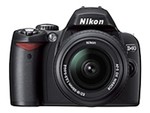 The Nikon D40 is a compact and lightweight high-performance camera that makes it possible for anyone to create stunning images with an SLR. Designed specifically for ease of use, the D40 lets you use the kind of digital and optical technologies that professionals use without the need to deal with complex functions. Whatever you shoot there is an automated Digital Vari Program that lets you achieve fantastic results in any situation. Help menus are easy to navigate and the in-camera retouch menu makes it simple to edit and enhance your images on the large, bright 2.5-inch LCD monitor. Perfect for people who want an affordable camera to explore what it is that makes SLR photography stand out, the D40 is so user-friendly that all you have to do is concentrate on the scene you want to photograph and the camera's advanced Nikon technologies will take care of the rest.
The Nikon D40 is a compact and lightweight high-performance camera that makes it possible for anyone to create stunning images with an SLR. Designed specifically for ease of use, the D40 lets you use the kind of digital and optical technologies that professionals use without the need to deal with complex functions. Whatever you shoot there is an automated Digital Vari Program that lets you achieve fantastic results in any situation. Help menus are easy to navigate and the in-camera retouch menu makes it simple to edit and enhance your images on the large, bright 2.5-inch LCD monitor. Perfect for people who want an affordable camera to explore what it is that makes SLR photography stand out, the D40 is so user-friendly that all you have to do is concentrate on the scene you want to photograph and the camera's advanced Nikon technologies will take care of the rest.
Details
Dimensions (WxDxH):
12.6 cm x 6.4 cm x 9.4 cm
Weight:
475 g
Additional Features:
text input to Exif header
Lens Features
Optical Sensor Type:
CCD
Optical Sensor Size:
15.6 x 23.7mm
Maximum Focal Length:
135 mm, 55 mm
Minimum Focal Length:
18 mm
Display:
LCD display - TFT active matrix - 2.5" - color
Flash Features
Flash Type:
Pop-up flash
Red Eye Reduction:
Yes
Some notable new features: 1. Auto (no flash) mode. Without this mode the flash will pop-up (on all other pre-programmed mode) even when you don't want to use flash (which can be annoying) 2. In camera editing capability such as black and white, sepia and some filter effects etc. While sounds gimmicky, these features are useful especially for those who doesn't have Adobe Photoshop To date, D40 is the smallest and lightest among all the Nikon DSLR. I believe that choosing a camera that fits comfortably with your hands is important. Therefore, I recommend people to test the camera before buying About the 18-55mm II AF-S kit lens: A good lens producing sharp photos (though not a very fast lens). Also decent for close-up/macro photography. Lens uses internal focus technology and focusing operation is silent. A very decent kit lens. Lens compatibility: Notice that with D40, autofocus function will not work for non AF-S/AF-I lens. If you already have non AF-S Nikon lenses and want a backup or replacement camera, you will be better off buying D50, D70s or D80. If you buy the D40, it will be convenient to stick with AF-S type lenses. Here are the pros and cons of the D40 in my opinion: Pros: 1. Nice out of the camera result picture quality 2. Affordable price 3. Compact size and light weight 4. Large and bright 2.5 inch LCD 5. 2.5 frames per second 6. B/W, Sepia, several more in-camera editing features. 7. Instant power on, fast autofocus and no shutter lag 8. Noise is acceptable at high ISO settings. Auto ISO settings available. 9. Great 18-55mm II AF-S kit lens. 10. Great battery life (400-1000 on a single charge). 11. Auto (flash off) mode available 12. 1/500 flash sync Cons: 1. No direct button to change QUAL, WB and ISO settings 2. Grip comfortably but might be a bit too small for some people 3. No top LCD and no front command dial 4. Autofocus will not work with non AF-S lenses 5. No AF/MF switch 6. Only 3 autofocus point 7. 6 Megapixel (More Megapixel needed to print larger than 12 X 18 at 300 dpi) 8. No night landscape mode in pre-programmed settings 9. No in camera image stabilization (like Sony and Pentax) but Nikon has lenses with it (VR). 10. No depth-of-field preview button In conclusion, the D40 is perfect for those who want high quality pictures, more control, and have a DSLR experience (instant power on and no shutter lag), without having to carry a bulky camera. And unless you are shooting sports/actions professionaly), the D40 is pretty much all you will need.
My Score : 7.50
The Nikon D40 is a compact and lightweight high-performance camera that makes it possible for anyone to create stunning images with an SLR. Designed specifically for ease of use, the D40 lets you use the kind of digital and optical technologies that professionals use without the need to deal with complex functions. Whatever you shoot there is an automated Digital Vari Program that lets you achieve fantastic results in any situation. Help menus are easy to navigate and the in-camera retouch menu makes it simple to edit and enhance your images on the large, bright 2.5-inch LCD monitor. Perfect for people who want an affordable camera to explore what it is that makes SLR photography stand out, the D40 is so user-friendly that all you have to do is concentrate on the scene you want to photograph and the camera's advanced Nikon technologies will take care of the rest.
0 comments:
Post a Comment